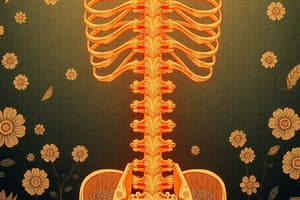Podcast
Questions and Answers
What is a key aspect of diagnosing ankylosing spondylitis?
What is a key aspect of diagnosing ankylosing spondylitis?
- Urinalysis
- Family history of arthritis (correct)
- Skin biopsy
- Liver function test
What is a common early symptom of ankylosing spondylitis before puberty?
What is a common early symptom of ankylosing spondylitis before puberty?
- Neck pain (correct)
- Knee pain
- Hand numbness
- Elbow stiffness
How does ankylosing spondylitis primarily affect the spine and pelvis?
How does ankylosing spondylitis primarily affect the spine and pelvis?
- Leads to muscle weakness
- Results in fusion of vertebrae (correct)
- Creates bone spurs
- Causes swelling in the joints
Which factor is NOT considered a potential cause of ankylosing spondylitis?
Which factor is NOT considered a potential cause of ankylosing spondylitis?
What is a common management approach for ankylosing spondylitis?
What is a common management approach for ankylosing spondylitis?
Why is early diagnosis of ankylosing spondylitis important?
Why is early diagnosis of ankylosing spondylitis important?
Flashcards are hidden until you start studying
Study Notes
Ankylosing Spondylitis
Ankylosing spondylitis is a form of arthritis characterized by inflammation where the spine joins your pelvis. It most commonly affects males under the age of 40 and can also cause stiffness in other joints such as hips, shoulders, and knees. The condition may develop slowly over time, with symptoms sometimes so mild they go unrecognized until the disease has progressed significantly.
Causes
The exact cause of ankylosing spondylitis is unknown. However, it's likely caused by a combination of genetic, environmental, and possibly immune system factors. People who have family members with this type of arthritis are more likely to get it themselves.
Symptoms
Early symptoms often occur before puberty and include:
- Pain in the lower back and buttocks
- Stiff neck and shoulders
- Reduced mobility in the spine
- Pain in various joints
Later stages involve fusion of the vertebrae in the spine, which results in loss of mobility that can affect the ability to work.
Diagnosis
A doctor will ask questions about your medical history and do physical examinations to diagnose ankylosing spondylitis. They might also order blood tests, X-rays, CT scans, bone scans, or MRI scans to rule out other conditions.
Management
There isn't a cure for ankylosing spondylitis, but treatments can help reduce pain and slow down the progression of the disease. Medications used include nonsteroidal anti-inflammatory drugs (NSAIDs), biologic agents like tumor necrosis factor inhibitors, pain relievers, and in some cases surgery. Physical therapy exercises can improve flexibility and range of motion.
Treatment Options
Treatment for ankylosing spondylitis aims to manage symptoms and prevent damage. This involves medication like NSAIDs and opioids for short-term pain relief, TNF inhibitors if the disease doesn't respond well to NSAIDs, and corticosteroids for inflammation. Surgery is considered when severe disability occurs despite optimal medical management.
Studying That Suits You
Use AI to generate personalized quizzes and flashcards to suit your learning preferences.



